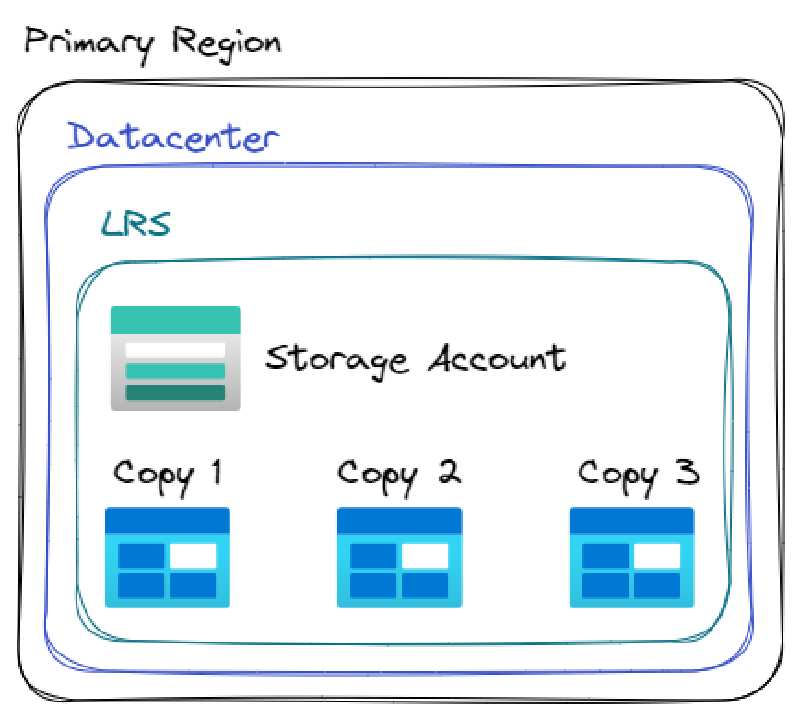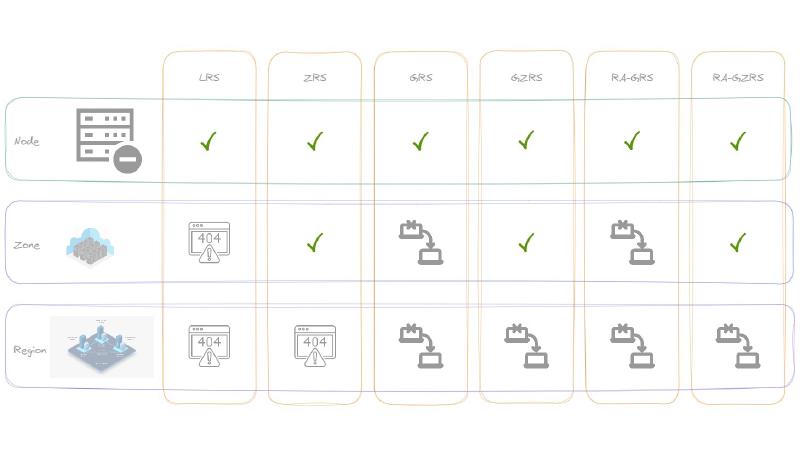🔹 Azure Storage Redundancy: Availability & Durability

Azure Storage automatically stores multiple copies of your data to protect against failures, power outages, and even massive natural disasters. Redundancy ensures that your data remains available and durable even when failures occur.
This guide covers all redundancy options available in Azure Storage and how they impact data durability, availability, and failover scenarios.
🌍 Primary Region Redundancy
Azure Storage always maintains three copies of your data in the primary region. There are two replication options:
🔹 LRS (Locally Redundant Storage)
🔹 ZRS (Zone-Redundant Storage)
🟢 Locally Redundant Storage (LRS)
LRS synchronously copies your data three times within a single physical location in the primary region.
✅ Lowest-cost option
⚠️ Not recommended for applications requiring high availability

🔵 Zone-Redundant Storage (ZRS)
ZRS synchronously replicates data across three availability zones within the primary region.
✅ Recommended for high-availability applications
✅ Protects against data center failures

🌎 Secondary Region Redundancy (Geo-Redundancy)
For higher durability, Azure allows replicating data to a secondary region, located hundreds of miles away from the primary region.
When creating a storage account, you select the primary region, and Azure assigns a paired secondary region (which cannot be changed).
Azure Storage provides two geo-redundancy options:
🔹 GRS (Geo-Redundant Storage)
🔹 GZRS (Geo-Zone-Redundant Storage)
Key Difference: In both cases, the secondary region always uses LRS (three copies) for durability. However, the primary region’s replication method differs.
🟡 Geo-Redundant Storage (GRS)
GRS copies data:
- Synchronously (LRS) within the primary region
- Asynchronously to a single physical location in the secondary region
✅ Protects against regional outages
⚠️ Data in the secondary region is not readable unless failover occurs

🔴 Geo-Zone-Redundant Storage (GZRS)
GZRS combines the benefits of ZRS + GRS:
- Synchronously (ZRS) replicates across three availability zones in the primary region
- Asynchronously copies to a single location in the secondary region
✅ Best for mission-critical applications
✅ Protects against both zonal & regional failures

📖 Read Access to Secondary Region
By default, GRS and GZRS replicate data to a secondary region but do not allow direct access.
However, if your application requires read access to the secondary region during a primary region outage, you can enable:
🔹 Read-Access Geo-Redundant Storage (RA-GRS)
🔹 Read-Access Geo-Zone-Redundant Storage (RA-GZRS)
✅ Data can be read from the secondary region
⚠️ Secondary region lags behind the primary (async replication)
Note: In a disaster scenario, some data might be lost since replication to the secondary region is asynchronous.

📊 Comparison: Durability & Availability
Durability & Availability Parameters
| Parameter | LRS | ZRS | (RA-)GRS | (RA-)GZRS |
|---|---|---|---|---|
| Durability (per year) | ≥ 11 9’s | ≥ 12 9’s | ≥ 16 9’s | ≥ 16 9’s |
| Availability (read requests) | ≥ 99.9% (99% for Cool/Archive) | ≥ 99.9% (99% for Cool/Archive) | ≥ 99.9% for GRS / 99.99% for RA-GRS | ≥ 99.9% for GZRS / 99.99% for RA-GZRS |
| Availability (write requests) | ≥ 99.9% (99% for Cool/Archive) | ≥ 99.9% (99% for Cool/Archive) | ≥ 99.9% | ≥ 99.9% |
| Number of copies of data | 3 copies (single location) | 3 copies (across zones) | 6 copies (3 primary + 3 secondary) | 6 copies (ZRS primary + LRS secondary) |
Availability Based on Outage Scenarios
| Failure Scenario | LRS | ZRS | (RA-)GRS | (RA-)GZRS |
|---|---|---|---|---|
| Node failure within a data center | ✅ | ✅ | ✅ | ✅ |
| Single data center failure | ❌ | ✅ | ✅ | ✅ |
| Primary region failure (regional outage) | ❌ | ❌ | ✅ | ✅ |
| Read access to secondary during primary outage | ❌ | ❌ | ✅ (RA-GRS) | ✅ (RA-GZRS) |
🏆 Which Azure Storage Redundancy Should You Choose?
| Use Case | Best Option |
|---|---|
| Cost-sensitive workloads, backups, non-critical data | LRS |
| High availability within the primary region | ZRS |
| Disaster recovery and regional failover protection | GRS |
| Mission-critical workloads requiring both zonal & regional protection | GZRS |
| Applications requiring immediate read access to secondary | RA-GRS / RA-GZRS |
🛠 Final Thoughts
Azure Storage offers multiple redundancy options to ensure data durability and availability. Choosing the right replication strategy depends on:
✔️ Business requirements – Do you need cross-region failover?
✔️ Cost considerations – ZRS and GZRS are costlier but offer better availability.
✔️ Read requirements – Do you need read access to the secondary region?
If you’re running mission-critical applications, GZRS (or RA-GZRS) is your best bet. Otherwise, ZRS or GRS might be sufficient depending on your redundancy needs.
🚀 What’s your go-to storage redundancy option? Drop a comment below! 👇